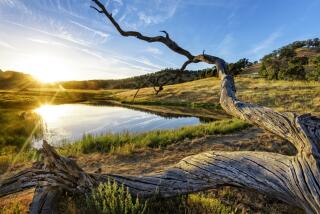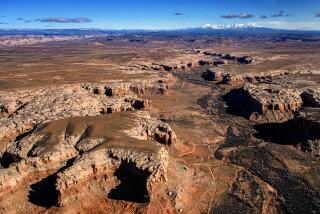â88 Letter Casts Doubt on Hope Land Exchange : Jordan Ranch: A congressman says correspondence by an ex-secretary of the Interior may show that the Park Service lacks the authority to OK the deal.
WASHINGTON â The chairman of a congressional subcommittee that oversees the National Park Service says that a 1988 letter concerning Cheeseboro Canyon in Ventura County raises new questions about the National Park Serviceâs authority to approve a controversial swap of federal land without legislation by Congress.
At issue is whether the Park Service could proceed with a proposed exchange of 59 acres of federally owned land in Cheeseboro Canyon for about 1,100 acres that entertainer Bob Hope owns on the adjacent Jordan Ranch. Opponents of the deal have sought to shift the decision-making process from the agency to Congress, where they maintain it would probably receive a more critical review.
The Park Service has not taken a formal position on the exchange pending completion of its environmental impact review, but top agency officials have expressed support for the proposal in the past.
Potomac Investment Associates, which has an option to buy the 2,308-acre Jordan Ranch from Hope, is seeking to build 750 estate houses and a tournament golf course on the ranchâs remaining 1,208 acres. They need the 59 acres of Cheeseboro for an access road to the development from the Ventura Freeway. Hope has agreed to sell another 4,600 acres of mountain property to public agencies at a below-market $10 million if the exchange is approved.
Rep. Bruce F. Vento (D-Minn.), chairman of the Interior Committeeâs subcommittee on national parks and public lands, asked Park Service Director James M. Ridenour recently whether the agency has authority to trade away part of Cheeseboro Canyon.
In an interview, Vento said that, under a literal reading of the law, the Park Service does ânot appear to have authority.â
Vento has asked Ridenour to obtain a legal opinion on this question from the Interior Departmentâs solicitor. Rep. Mike Synar (D-Okla.) made the same request when his government operations subcommittee on environment, energy and natural resources held an oversight hearing on the proposed swap last month.
Federal law permits the Interior secretary to approve land swaps within a state if the properties are deemed of equal value or a cash payment is made to the government to equalize the values.
But the law forbids such an administrative exchange when it would change the boundaries of a national park, which requires congressional approval. Cheeseboro Canyon and Jordan Ranch are within the contours of the Santa Monica Mountains National Recreation Area, a 150,000-acre patchwork of houses, other private holdings and public land.
Ventoâs query was prompted by a Feb. 10, 1988, letter from then-Interior Secretary Donald P. Hodel to key members of Congress advising them that he was making a minor boundary change to the park to incorporate two parcels at the southern end of Cheeseboro Canyon next to Agoura Hills. The secretary has the authority to take such an action but is required to inform the chairmen of the House and Senate committees that oversee the Interior Department.
About half of one of the parcels--30 acres that was purchased by the Park Service in 1985--is part of the 59 acres in the proposed swap. A second 20-acre parcel, which was donated to the Park Service, is not.
Donald J. Hellmann, associate counsel for the Wilderness Society, a leading opponent of the swap, said a boundary revision that was required to add the 30-acre parcel to the park proves that a boundary change would also be needed to remove it from federal ownership.
âWith this evidence, I donât see any question whatsoever that this type of exchange requires legislation,â Hellmann said.
But Willis P. Kriz, chief of the Park Serviceâs land resources division, said Hodelâs letter does not have any bearing on the question of a boundary change in the exchange.
âThe two actions are separate and independent of each other,â Kriz said.
Peter Kirsch, an attorney representing Potomac, also said that Hodelâs letter, which he noted has long been in the public domain, does not buttress Hellmannâs claim that legislation is needed for the exchange.
Unlike other national parks that consist of only federally owned land, Kirsch said, much of the sprawling Santa Monica Mountains Recreation Area is made up of houses, businesses and other pieces of privately owned property. Therefore, although a boundary change was legally required to incorporate part of Cheeseboro Canyon, transferring the 59 acres to a private party does not remove it from the recreation area.
More to Read
Sign up for Essential California
The most important California stories and recommendations in your inbox every morning.
You may occasionally receive promotional content from the Los Angeles Times.










